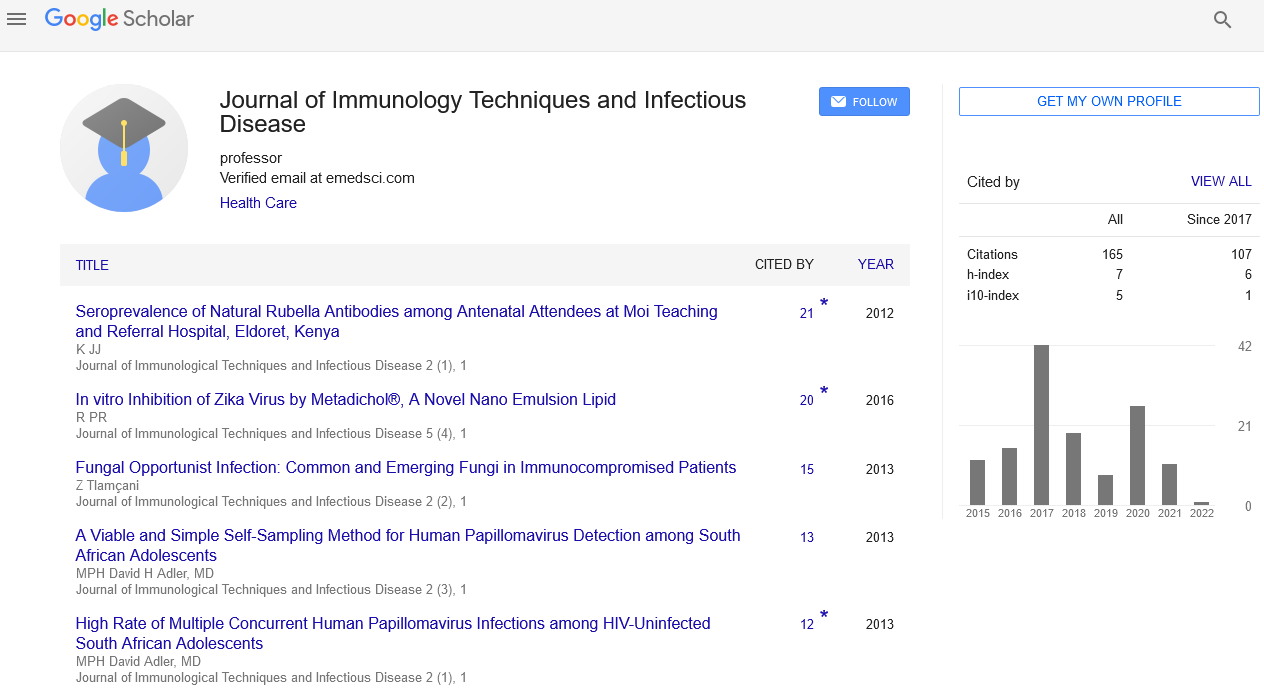Opinion Article, J Immunol Tech Infect Dis Vol: 12 Issue: 1
Types of Immune Responses: Innate and Acquired Immunity
Wen Negishi*
Department of Microbiology and Immunology, Nippon Medical School, Tokyo, Japan
*Corresponding Author: Wen Negishi
Department of Microbiology and Immunology, Nippon Medical School, Tokyo, Japan
E-mail: wennegishi@123.com
Received date: 01-Feb-2023, Manuscript No. JIDIT-23-92843;
Editor assigned date: 03-Feb-2023, PreQC No. JIDIT-23-92843 (PQ);
Reviewed date: 17-Feb-2023, QC No. JIDIT-23-92843;
Revised date: 24-Feb-2023, Manuscript No. JIDIT-23-92843 (R);
Published date: 03-Mar-2023, DOI: 10.4172/2329-9541.1000333.
Citation: Negishi W (2023) Types of Immune Responses: Innate and Acquired Immunity. J Immunol Tech Infect Dis 12:1.
Description
Organs, cells, proteins, and tissues comprise the immune system. This system is in charge of resisting the body against invading pathogens as well as removing dead and dysfunctional cells. Humans currently have three types of immunity- passive, innate, and adaptive. The innate immune system serves as the body's first line of defence against pathogens. Because it reacts in the same manner to all pathogens and foreign chemicals, it is also referred to as the "nonspecific" immune system. It works fast, for example, ensuring that bacteria that enter the skin through a minor wound are recognised and eliminated on the spot within a few hours. However, the innate immune system has little ability to prevent pathogens from spreading. The innate immune system is made up of the following components.
• Protection provided by the skin and mucous membranes
• Protection provided by immune system cells (defence cells) and proteins
If the innate immune system is unable to eradicate the germs, the adaptive immune system takes over. It particularly targets the sort of pathogen that infects. However, it must first detect the germ. This means that it is slower to respond than the innate immune system, but it is more accurate when it does. It also has the advantage of being able to recognize germs so that the adaptive immune system can respond faster the next time a known germ is encountered. This memory is also the reason why some illnesses can only be contracted once in a lifetime because the body becomes "immune" afterward.
The adaptive immune system may take a few days to respond the first time it comes into contact with the pathogen, but the body can respond promptly the next time. The second infection is frequently not recognised or is much milder. T lymphocytes in the tissue between the body's cells make up the adaptive immune system.
• B lymphocytes, which are also located in the tissue between the cells of the body,
• Antibodies found in body fluids and blood
They are produced by the immune system in order to combat pathogens and foreign things. Antibodies detect bacteria and other potentially hazardous chemicals quickly and adhere to them. This neutralises the "intruders" and draws the assistance of additional immune system cells. B cells are responsible for the production of antibodies. Antigens are germs and other things that can stimulate the production of antibodies. An antibody will only bind to an antigen if it matches exactly, like a key in the antibody's lock. This is how antibodies detect matched bacteria and trigger a rapid adaptive immune response. Antibodies have three primary purposes.
• They kill germs by adhering directly to the cell surfaces of viruses or bacteria or by attaching to their toxins. This stops bacteria from connecting to and infecting normal bodily cells.
• They stimulate other immune system cells by attaching to their surfaces. Scavenger cells, which are also loaded with antibodies, are better able to fight off infections.
• They activate proteins that aid in the immune system's response. The adaptive immune system's antibodies also help the innate immune system.
 Spanish
Spanish  Chinese
Chinese  Russian
Russian  German
German  French
French  Japanese
Japanese  Portuguese
Portuguese  Hindi
Hindi 
